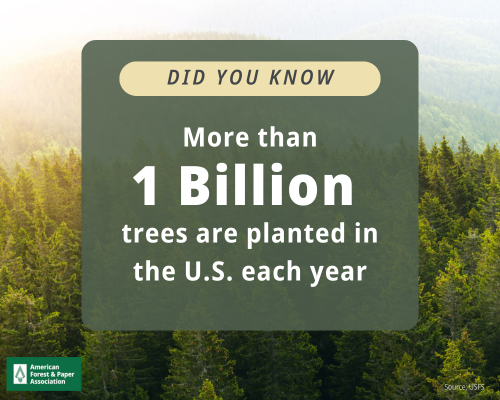Are Toilet Paper and Paper Towels Sustainable?
Why Toilet Paper and Paper Towels are a Responsible Choice
Key Takeaways
Our industry uses wood that is unsuitable for building materials and recycled paper to make toilet paper and paper towels. Making these products is a lot like following a recipe. Recycled paper and wood pulp help manufacturers deliver different qualities. U.S. tissue manufacturers need to balance using fresh wood pulp and recycled paper for a few reasons.
Toilet paper and paper towels are common staples in the home. Millions of people across the U.S. rely on paper products. Our industry prioritizes sustainable manufacturing and practices.
Below we answer common questions about toilet paper and paper towels. Dive in and explore why they are a responsible choice.
How are Toilet Paper and Paper Towels Made in the U.S.?
The U.S. tissue industry uses 2 primary inputs to make toilet paper and paper towels.
Wood
We take wood sourcing seriously.
Our members use wood that’s not suitable for building materials. This includes:
- Branches
- Tree tops
- Stumps
- Bark
- Wood byproducts from sawmills
These wood materials come from sustainably managed working forests where trees are replanted.
AF&PA members adhere to sustainable fiber procurement principles. In fact, it’s a condition of membership. Procurement is how our members source the wood pulp materials they need to make the products people rely on.
These principles assure our members their suppliers are committed to sustainable forest management and harvesting practices.
Recycled Paper
Recycled Paper

More than 90% of U.S. tissue manufacturers use recycled paper to make their products.
The recycled paper can go directly into the paper towel or toilet paper. It is also often used in packaging like the paperboard tubes these products are wrapped around.
In 2023, tissue producers used about 3.9 million tons of recycled paper. According to Fisher International, North American tissue manufacturers use more recycled paper in their products than those made in Europe and Asia.
Is it Better to Use Recycled Paper or Wood to Make Paper Towels and Toilet Paper?
It depends on customer preferences. Recycled paper and wood pulp help paper towel and toilet paper manufacturers deliver different qualities such as
- Absorbency
- Strength
- Versatility
- Durability
- Softness
- Recycled content
- Budget
Each of these qualities has different requirements. It’s a lot like following a recipe. Recycled paper and wood pulp have different properties that alter the final product. Similar to how different types of flour affect the outcome of a baked good.
U.S. paper towel and toilet paper manufacturers adjust the inputs they use based on what qualities they’re trying to create to meet customer demand. This gives customers multiple options so they can choose what works best for them.
Can U.S. Tissue Producers Use Only Recycled Paper to Make Paper Towels and Toilet?
U.S. paper towel manufacturers need to balance using both fresh wood pulp and recycled paper for a few reasons:
Limited Resources
The amount and type of recycled paper to make toilet paper and paper towels is limited. If the U.S. paper industry used only recycled paper to make all our products, including packaging, paper, pulp and tissue, we would run out in about 7 months.
During the recycling process, the fibers that makeup paper pulp get shorter and weaker. Eventually, they can no longer be used, and fresh wood pulp is needed.
Market Dynamics

The type of recycled paper primarily used in tissue products is mixed office paper. The amount of available mixed office paper is going down, which affects how much tissue producers can use.
Also, most of the available recycled paper manufacturers can use is from brown packaging. This is not appropriate for making white paper towels, toilet paper or other tissue products.
Like a recipe, manufacturers have to use the right mix of ingredients to make their products.
Meeting Customer Preferences
Recycled paper and fresh wood pulp produce paper towels and toilet paper with different qualities. Certain characteristics can only be achieved using fresh wood pulp.
Does Using Paper Towels and Toilet Paper Cause Deforestation?

No. The U.S. pulp and paper industry, which includes paper towel producers, is not linked to global deforestation.
U.S. forest managers have kept U.S. forestland stable since the 1950s through planting and natural regeneration. Today:
- 1/3 of the U.S. is forested.
- The net forest area in the U.S. has increased steadily in the past 30 years.
- More than 1 billion trees are planted in the U.S. each year.
Our industry uses trees from managed, working forests. These forests are continuously replanted, ensuring a healthy balance for the future.
Foresters, biologists, conservationists and other professionals work together to ensure there are healthy forests for years to come.
How Does the Paper Industry Prioritize Sustainability?
Sustainable practices are the foundation of our industry.
In 2011, AF&PA was one of the first manufacturing industries to set quantifiable sustainability goals. AF&PA members met or exceeded many of those goals.
Our members are leading the way towards a more sustainable future with 5 quantifiable sustainability goals they aim to achieve by 2030.
These commitments are about taking action. Our members are continually innovating to:
- Improve water management
- Reduce emissions
- Enhance wildlife habitats
- Capture more recycled material
Discover what sustainability in action looks like in the paper industry.
Download MIT Case Study
We developed a case study with MIT looking at what happens if tissue producers used 10% more recycled paper when making products.

Advancing Resilient U.S. Forests
AF&PA members have a 2030 sustainability goal to advance resilient U.S. forests. Explore what we’re aiming to accomplish.

Virtual Forest Tour
Want to see how working forests operate? Do a virtual forest walk through with Georgia-Pacific.

